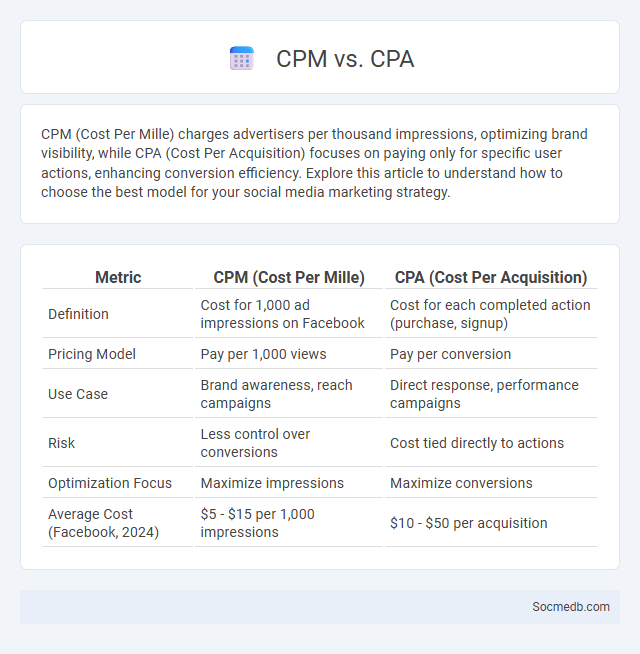
Photo illustration: CPM vs CPA
CPM (Cost Per Mille) charges advertisers per thousand impressions, optimizing brand visibility, while CPA (Cost Per Acquisition) focuses on paying only for specific user actions, enhancing conversion efficiency. Explore this article to understand how to choose the best model for your social media marketing strategy.
Table of Comparison
| Metric | CPM (Cost Per Mille) | CPA (Cost Per Acquisition) |
|---|---|---|
| Definition | Cost for 1,000 ad impressions on Facebook | Cost for each completed action (purchase, signup) |
| Pricing Model | Pay per 1,000 views | Pay per conversion |
| Use Case | Brand awareness, reach campaigns | Direct response, performance campaigns |
| Risk | Less control over conversions | Cost tied directly to actions |
| Optimization Focus | Maximize impressions | Maximize conversions |
| Average Cost (Facebook, 2024) | $5 - $15 per 1,000 impressions | $10 - $50 per acquisition |
Introduction to Digital Advertising Models
Digital advertising models encompass various strategies such as pay-per-click (PPC), cost-per-impression (CPM), and cost-per-acquisition (CPA) to optimize marketing efforts on social media platforms. These models enable precise targeting by leveraging user data and behavior analytics, enhancing ad relevance and conversion rates. By selecting appropriate models based on campaign goals, businesses maximize return on investment (ROI) and improve audience engagement.
What is CPM (Cost Per Mille)?
CPM (Cost Per Mille) represents the advertising cost for one thousand impressions on social media platforms like Facebook, Instagram, and LinkedIn. Marketers use CPM to evaluate the efficiency of ad campaigns by measuring how much they pay for every 1,000 views or impressions their ads receive. CPM rates vary based on factors such as target audience, ad placement, and platform engagement levels, influencing overall campaign budgeting and performance.
Understanding CPA (Cost Per Action)
Cost Per Action (CPA) in social media marketing measures the cost an advertiser pays when a user completes a specific action, such as a purchase, sign-up, or download. This pricing model enables precise budget control and ROI tracking by linking expenses directly to measurable conversions. Understanding CPA helps marketers optimize campaigns for higher efficiency by targeting audiences more likely to perform desired actions.
How Ad Auctions Work
Social media ad auctions operate by allowing advertisers to bid for ad space based on targeting criteria such as demographics, interests, and behaviors. The platform evaluates bids using a combination of bid amount, ad quality, and estimated user engagement to determine the winning ad. Your ad's success depends on crafting compelling content that maximizes relevance and interaction to outperform competitors in the auction.
CPM vs CPA: Key Differences
CPM (Cost Per Mille) charges advertisers based on every thousand impressions, making it ideal for brand awareness campaigns, while CPA (Cost Per Action) charges only when a specific action, like a purchase or signup, occurs, ensuring you pay solely for conversions. CPM pricing drives broad reach and visibility on social media platforms such as Facebook and Instagram, whereas CPA focuses on measurable results linked to user engagement and ROI. Choosing between CPM and CPA depends on whether your goal is maximum exposure or optimized cost-efficiency for your social media advertising strategy.
Ad Auction vs Traditional Pricing Models
Social media platforms use ad auctions to determine pricing and placement of ads, allowing advertisers to bid for targeted impressions based on user data and engagement metrics. This model contrasts with traditional fixed pricing, where advertisers pay set fees without real-time competition, often leading to less efficient budget allocation. Understanding these differences helps you optimize your ad spend by leveraging dynamic bids and audience targeting in social media ad auctions.
Pros and Cons of CPM
CPM (Cost Per Mille) in social media advertising offers the advantage of predictable budgeting by charging advertisers for every thousand impressions, making it ideal for brand awareness campaigns. However, CPM may not guarantee user engagement or conversions, which can lead to inefficient spending if your goal is direct response or sales. Understanding CPM helps you optimize ad strategies by balancing reach with performance metrics to ensure effective use of your marketing budget.
Pros and Cons of CPA
Cost Per Action (CPA) advertising on social media offers highly targeted performance-based marketing, allowing businesses to pay only when a specific action, such as a sale or sign-up, occurs, maximizing return on investment. This model enhances budget efficiency and drives measurable results but can be challenging due to potential fraud, high competition for quality leads, and the need for continuous optimization to maintain profitability. Brands benefit from precise audience targeting and control over campaign costs, though they must address the complexity of tracking conversions accurately across multiple social platforms.
Choosing the Best Model for Your Campaign
Selecting the best social media model for your campaign hinges on understanding audience behavior and platform algorithms to maximize engagement. In-depth analysis of demographic data and user interactions helps tailor content formats, whether influencer partnerships, paid ads, or organic reach strategies. Leveraging predictive analytics tools improves campaign performance by optimizing budget allocation and targeting for the highest ROI on platforms like Instagram, Facebook, and TikTok.
Future Trends in Digital Ad Pricing
Future trends in digital ad pricing indicate an increasing reliance on artificial intelligence and machine learning to optimize bid strategies and improve ROI for advertisers. Programmatic advertising will dominate, with dynamic pricing models adapting in real-time based on user behavior, engagement metrics, and contextual relevance. Privacy regulations and cookie-less tracking will drive the adoption of first-party data and alternative targeting methods, influencing cost structures and pricing transparency in social media advertising.
 socmedb.com
socmedb.com